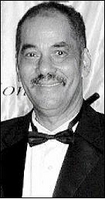Few bands keep horn section alive
Published: Sunday | September 27, 2009

Frankie Campbell - File
The horns are an important aural and visual component of the Fabulous Five Incorporated band's recordings and performances, especially as they deliver soca music and their extensive repertoire of popular Jamaican recordings.
However, the show band, which also does some backing duties, did not have a horn section when they started out in 1970. The band's manager and bass player, Frankie Campbell, put their beginnings as a rhythm combo in the context of broader music trends, explaining to The Sunday Gleaner that in the big band era the horns took pride of place.
He said there was usually a grand piano, guitar, trap set (drums) and double bass (this being the pre-electronic music era). "Everything else was horns," he said, most bands having about six horn players and some 10 to 12. Then, in the electronic era, heading into the 1960s, the rhythm section became more prominent, although the horns were still popular.
He noted the declining prominence of horns in Jamaica's popular music, from their predominant position in ska where they led many an instrumental through to rocksteady where there were horns but the rhythm got more popular and then came rhythm-driven reggae. One band, however, played a huge role in showing that popular music without horns could work.
more economical
The Beatles came with just guitars and drums and "showed you can still have a small combo basically playing rhythm music". Not only was it more economical, as a band could now be smaller, but also there were newer amplifiers to make the music louder.
So when Fab Five started in 1970, Byron Lee and the Dragonaires and Sonny Bradshaw's band had horn sections but they were mostly combos. They did quite well, Shaving Cream among the early hits, then in the mid-1980s came an experiment that worked.
Fab Five did Yu Safe and it became a hit, not only in Jamaica. "When we did Yu Safe album, we were forced to incorporate horns," Campbell said. And, of course, in playing the music live they have to present it as it is on the record. Hence, since 1986, they have had a horn section and Campbell says, "We will never ever not have a horn section again. We are not really purists, but we like the live sound.
"It gives the music that authentic sound," he said.
Tafawee Buchsaecab has seen that authenticity on the road. He says, "When you tour, especially in Europe, there is nothing to beat live horns. All the biggest reggae bands in Europe have live horns. It is like a must."
Tony Greene laments the deficiency of horn sections when Jamaican 'oldies' music is being played live. "And I say 'What's going on'?" he demanded. "I say, 'Why are we short-changing the people them money'?"
He also sees it in the studio, as "at this point we have few producers; we have reducers".
Fab Five has a two-man horn section, trumpet and trombone, with keyboard player Sydney Thorpe filling out the sound. Campbell counts Lloyd Parkes and We The People, Errol Lee and the Bare Essentials and Byron Lee and The Dragonaires as bands with horn sections, a sole horn (Dean Fraser) in the band that plays for Tarrus Riley and In2Nation carrying a horn section sometimes. "Some of the other touring people have horns, like Bunny Wailer, but they don't do many shows in Jamaica," he pointed out.
The deficiency is hurting not only the sound of the music, but also the musicians, as the bandstand is key to a horn player's development
"If them don't go out there them won't improve. Practice at home is great, but you have to perform," Greene said.
- Mel Cooke
















